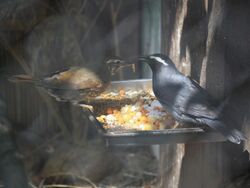Biology:Geokichla
| Geokichla | |
|---|---|

| |
| Siberian thrush (Geokichla sibirica) | |
| Scientific classification | |
| Domain: | Eukaryota |
| Kingdom: | Animalia |
| Phylum: | Chordata |
| Class: | Aves |
| Order: | Passeriformes |
| Family: | Turdidae |
| Genus: | Geokichla S. Müller, 1836 |
| Type species | |
| Turdus citrinus[1] Latham, 1790
| |
The Geokichla thrushes are medium-sized mostly insectivorous or omnivorous birds in the thrush family, Turdidae. They were traditionally listed in the Zoothera, but molecular phylogenetic studies published in 2008 led to their placement in a separate genus.
Taxonomy
The genus Geokichla was introduced in 1836 by the German naturalist Salomon Müller with Turdus citrinus Latham, 1790, the orange-headed thrush, as the type species.[2][3][4] The genus name combines the Ancient Greek geō- meaning "ground-" with kikhlē meaning "thrush.[5]
These species were formerly placed in the genus Zoothera. Molecular phylogenetic analysis by Gary Voelker and collaborators published in 2008 found that Zoothera was polyphyletic.[6][7] To create monophyletic genera 21 species were moved from Zoothera to the resurrected genus Geokichla.[8]
List of species
The genus contains the following 21 species:[8]
- Siberian thrush, Geokichla sibirica
- Pied thrush, Geokichla wardii
- Grey ground thrush, Geokichla princei
- Black-eared ground thrush, Geokichla camaronensis
- Spotted ground thrush, Geokichla guttata - formerly G. fischeri
- Spot-winged thrush, Geokichla spiloptera
- Crossley's ground thrush, Geokichla crossleyi
- Abyssinian ground thrush, Geokichla piaggiae
- Kivu ground thrush, Geokichla piaggiae tanganjicae
- Oberländer's ground thrush, Geokichla oberlaenderi
- Orange ground thrush, Geokichla gurneyi
- Orange-headed thrush, Geokichla citrina
- Buru thrush, Geokichla dumasi
- Seram thrush, Geokichla joiceyi
- Orange-sided thrush, Geokichla peronii
- Slaty-backed thrush, Geokichla schistacea
- Chestnut-capped thrush, Geokichla interpres
- Enggano thrush, Geokichla leucolaema
- Chestnut-backed thrush, Geokichla dohertyi
- Ashy thrush, Geokichla cinerea
- Red-backed thrush, Geokichla erythronota
- Red-and-black thrush, Geokichla mendeni
A subfossil specimen of a ground thrush has been found on the island of Mauritius:[9]
- Mauritius ground thrush, Geokichla longitarsus
References
- ↑ "Turdidae". The Trust for Avian Systematics. https://www.aviansystematics.org/4th-edition-checklist?viewfamilies=182.
- ↑ Müller, Salomon (1836). "Aanteekeningen, over de natuurlijke gesteldheid van een gedeelte der westkust en binnenlanden van Sumatra, met bijvoeging van eenige waarnemingen en beschrijvingen van verscheidene op dit, en andere Sunda-eilanden voorkomende dieren" (in Dutch). Tijdschrift voor Natuurlijke Geschiedenis en Physiologie 2: 315–355 [348–349]. https://books.google.com/books?id=DxkFAAAAQAAJ&pg=PA348.>
- ↑ Mayr, Ernst; Paynter, Raymond A. Jr, eds (1964). Check-List of Birds of the World. 10. Cambridge, Massachusetts: Museum of Comparative Zoology. p. 144. https://www.biodiversitylibrary.org/page/14486333.
- ↑ Dickinson, E.C.; Christidis, L., eds (2014). The Howard & Moore Complete Checklist of the Birds of the World. 2: Passerines (4th ed.). Eastbourne, UK: Aves Press. p. 619. ISBN 978-0-9568611-2-2.
- ↑ Jobling, James A. (2010). The Helm Dictionary of Scientific Bird Names. London: Christopher Helm. p. 172. ISBN 978-1-4081-2501-4. https://archive.org/stream/Helm_Dictionary_of_Scientific_Bird_Names_by_James_A._Jobling#page/n172/mode/1up.
- ↑ Voelker, G.; Klicka, J. (2008). "Systematics of Zoothera thrushes and a synthesis of true thrush molecular relationships". Molecular Phylogenetics and Evolution 49: 377–381. doi:10.1016/j.ympev.2008.06.014.
- ↑ Voelker, G.; Outlaw, R.K. (2008). "Establishing a perimeter position: speciation around the Indian Ocean Basin". Journal of Evolutionary Biology 21 (6): 1779–1788. doi:10.1111/j.1420-9101.2008.01588.x.
- ↑ 8.0 8.1 Gill, Frank; Donsker, David; Rasmussen, Pamela, eds (July 2023). "Thrushes". IOC World Bird List Version 13.2. International Ornithologists' Union. http://www.worldbirdnames.org/bow/thrushes/.
- ↑ Hume, J.P. (2022). "A new subfossil ground thrush (Turdidae: Geokichla) from Mauritius, Mascarene Islands". Bulletin of the British Ornithologists' Club 142 (4): 388–403. doi:10.25226/bboc.v142i4.2022.a2.
External links
| Wikimedia Commons has media related to Geokichla. |
- Asian thrush videos on the Internet Bird Collection
Wikidata ☰ Q26030 entry
 |

